
Wonderfold Wagon Review
Price $289
BUY NOWIf you (like me) have been eyeing the trendy stroller-wagons of the world with glassy eyes recently — but were hesitant to ever pull the trigger on one because of the steep price tag (typically ~$500+), keep reading.
Yes, the Wonderfold can be an economical option — the base models ($289+) are priced somewhat more reasonably than the available competition, such as the Veer or Keenz, which start at $649 and $449, respectively (though some of Wonderfold’s higher-end editions are $$$). Note that the Evenflo Pivot ($319), another recent addition to the stroller-wagon market, is also a strong contender.
I tried out the company’s simplest, economy version (the W1) to see what’s what. Big picture: it’s a super easy-to-use stroller-wagon with a smooth push, high weight capacity, and decent features. If you’re in the market, it’s 100% worth a look.
Disclaimer: I received the Wonderfold W1 Original Double Stroller Wagon to try out. This model is a two-seater and the most bare bones (and affordable) version the company offers. Upgrades offer more features and extra seating, but they all build on this basic model.
Who needs a stroller-wagon?
Stroller-wagons have been “all the rage” the last few years, and though there is SO much to love about them, they might not be the best fit for every family and most likely won’t replace your day-to-day stroller.
Instead, stroller-wagons can be super utilitarian for certain situations or kiddos. In particular, they are fantastic for:
- Leisurely field trips and outings such as the zoo, parks, the farmer’s market, ferry boats, beach, etc.;
- Children who don’t want to ride in strollers or simply don’t like strollers;
- Older children who might be outgrowing the stroller (and/or who demand to walk and then promptly complain that they’re too tired to walk, HAH);
- Meet-ups with friends (picnics, playdates, etc.);
- Multiple kids at a time who like to interact with one another.
Stroller-wagons tend to have a lot of versatility, but since they are cross-bred, so to speak, they’re not as good at “being strollers” as plain old strollers. Also… they’re BIG. But they are wonderful to have around, can be repurposed for things like carrying groceries, packages etc., and the hybrid design is super-convenient for the right situation.
Weight (& Size)
Like any stroller-wagon, the Wonderfold is neither small nor compact. At 33 pounds, it’s relatively heavy, and even when folded it takes up a good amount of space (see below for more on the fold) — but all of this is on par for the category.
Where it really shines is in the weight capacity, which, at a whopping 180 pounds, FAR surpasses any comparable stroller. Most double strollers — even the best — top out at about ~90 pounds max in terms of weight limit, but the W1 affords up to 90 pounds per seat. And most other 2-seat stroller-wagons, like the Veer Cruiser and the Keenz, have a weight of 110 pounds. This means that with the Wonderfold, you can pack a lot of weight — kid or cargo — without worrying about taking a toll on the product.
The question of what it feels like to push/pull 180 lbs of weight is a different matter altogether…
But first…
Wonderfold Wagon Models/Options
Wonderfold offers an assortment of stroller wagons, including some 4-seaters. (For additional details on the quad wagon offerings, see here, and you can also review this product comparison chart for more.) Here are the basics on the different series:
W2 — Original Double Series ~$419
This 2-seater is similar to the W1 but comes with removable seat backs, a front zipper door, and a little extra storage space. You can also upgrade to either the “Elite” (~$529) or “Luxe” (~$659) versions for more features, such as magnetic harness “clips,” all-terrain XL wheels, raised seats, and reclining seat backs.
W4 — Original Quad Series ~$595
The W4 is a 4-seater with high-backed seats (two in the front and two in the rear, both sets facing one another) and a footwell, a front zipper door, and extra storage. As with the W2 (above), the “W4 Elite” (~$699) and “W4 Luxe” (~$899, eek!) versions have some upgrades and extra features: reclining seats, more storage, magnetic harnesses, a neoprene handle cover, all-terrain XL tires, etc.
X2 — Push & Pull Series ~$369
The notable differences between the X and W series doubles are that the X series has a storage basket, removable seat pads, a boxier canopy (that is not adjustable), and *a telescoping pull handle (to use it like a traditional wagon). You can upgrade to magnetic harnesses for an extra $30.
X4 — Push & Pull Series ~$469
This quad stroller wagon has removable seat pads, a rear storage basket, a boxy full-service canopy that stays in one place, and the same push/pull feature as the X2. Also as with the X2, you can opt for the same wagon with magnetic harnesses for an additional $30.
Seating
This wagon comes with two 5-point safety harnesses that face each other; the strap-in seating is nice for children who tend to make a run for it, or for certain situations where you might want to buckle your children in (crossing a busy street, say), but I found I didn’t need or use the harnesses much. Instead, my kids loved having some mobility in the wagon — and many other parents indicate the same. (FYI — The company does not sanction this and recommends always using the safety harness for seating…)
Some folks complain that the “seating” is basically just the floor of the wagon and doesn’t offer much support. This is true, and though it wasn’t a particular problem for us, I could see how some families might be worried about comfort — some people opt to throw in a cushy blanket or something similar for kids to sit on. Problem solved. (Note that some other versions offer raised seating.)
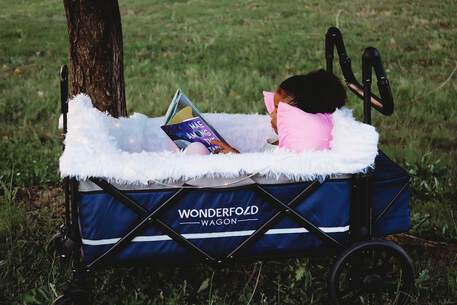
On the plus side, the flat base of the wagon means littles can easily lie down for a nap (and many parents even use it like a bassinet, though technically there’s a separate bassinet accessory that’s been through all the safety testing and whatnot). Wonderfold officially markets the stroller as suitable for 6+ months, assuming the baby has strong torso control and can sit up independently.
Fold
The W1 is easy to fold up and stands on its own (YES!), but it’s not small. (It took up ~⅔ of my Subaru Outback trunk, lying sideways).


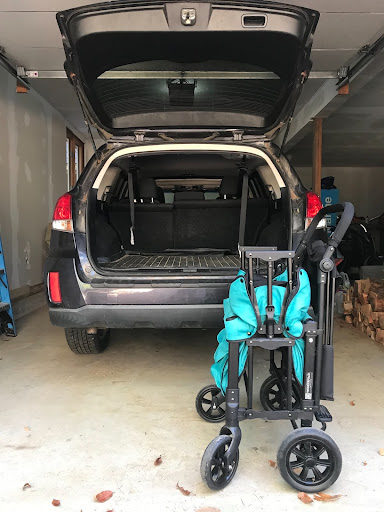
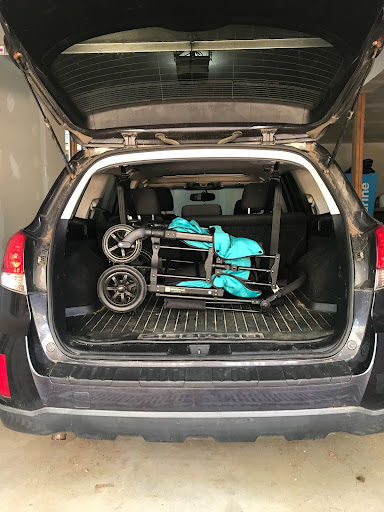
I love that the folded-up wagon is very easy to pull behind you, like a suitcase (see below).
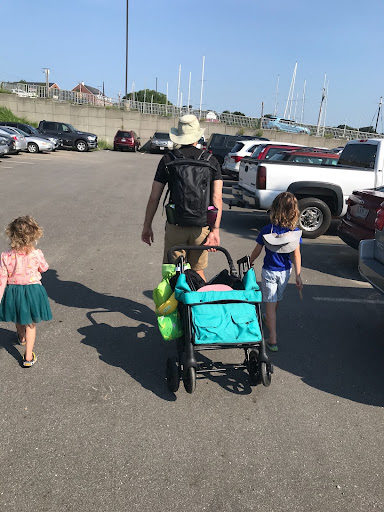
Note that for the W1 version, you have to remove the canopy to fold it up (which is easy to do, it’s just annoying that it then becomes a separate piece to keep track of), but the W2 version can fold with the canopy still attached (and also folds more compact compared to the W1).


Push & Pull
The push on the Wonderfold wagon is very smooth, but it really only excels on completely flat/level surfaces. I found that it was difficult to handle on gravel, trails, hills and on uneven roads (up here in Maine, the roads are all extra-concave for the snow, and trying to push this thing on the edge of the road, where the curve falls off, was a joke).
And the heavier the load (whether kids or kids and stuff), the harder you’ll have to work to stay on track, especially on more hilly/bumpy/inclined terrain. My two kids have a combined weight of almost 90 pounds, and it was a lot easier to handle with just one of them.
Tip — Have your heavier child sit closer to you to improve maneuverability.
When we were on a flat sidewalk, however, this thing was seriously a breeze to push — even fully weighed down. On smooth surfaces, it’s easy to push, glides really smoothly, and maneuvers well.
The handlebar height on the W1 is somewhat maneuverable with a swivel, which is a plus, but gosh I wish it swiveled farther. I’m relatively tall (5’9”) and had to constantly focus on keeping my feet from kicking the back of the wagon. Other tall parents complain about this, and one father even said “don’t buy this stroller if you are taller than 5 ‘9”.” Some users ~5’6” reported this problem as well — and it’s reportedly an issue with the W2, too. For me, this wasn’t a deal-breaker, but it was definitely very annoying and one of the reasons I wouldn’t necessarily recommend this as your one and only stroller. (**Some of the other/later Wonderfold wagon versions have an add-on handlebar extender accessory (~$49) that some say do fix this issue, but it wasn’t compatible with the W1, and I didn’t personally try it out.)
With the handlebar swiveled down, the Wonderfold is very easy for toddlers to push — which kids obviously love. I like this feature because if you’re using it as a true wagon, littles can help!
The W1 wagon comes with a pull strap, which frankly I didn’t find of much use, but other versions come with a pull handle (as would be on a traditional wagon), and parents love that feature.
A couple of other items of note in the “push” category:
- Brake: There’s a step-on foot brake that’s easy to engage and disengage even in sandals.
- Curbs: If you are going over/down curbs, know that it’s really a three-step process (lift, push/pull, then lift the other side). It’s not necessarily difficult (especially with two adults), but it’s something to consider.
Storage and Extras
Canopy
The soft UPF canopy on the Wonderfold is an awesome feature, and I Ioved that it was fully adjustable, so we could angle it one way or the other depending on the sun.
Storage
You can obviously use some of the wagon for storage, and there’s actually a decent amount of side-pocket storage and saddle storage bags, but there’s nowhere for a big bag or larger items (again, unless you have available wagon space).
Extras
The W1 2-seater doesn’t come with much (read: any) extra features, but you can purchase any number of add-on features (such as a bug net, 4-sided rain cover, wrap-around shading, “premium seating” (lol), add-on storage nets, snack/activity tray, parent console with 4 cupholders, etc., etc.), and other versions come with fancier details (more side storage space, adjustable-height canopies, all-terrain tires, etc.).
Wonderfold also makes 4-seater wagons which are roomier and have an even higher weight capacity.
Price
Compared to other stroller wagons, with intro pricing starting around ~$500 (i.e., Keenz at $449 and Veer at $649), the W1 Wonderfold 2-Seater Wagon (~$289) is probably the most affordable option in the category.
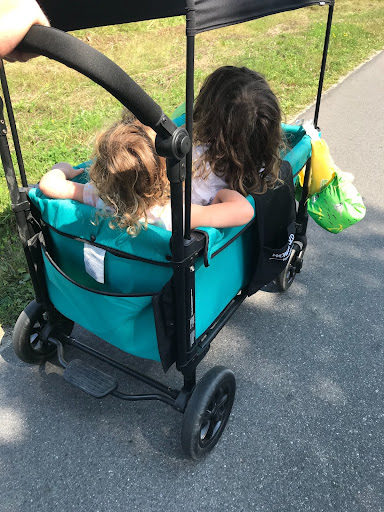
Bottom Line
The Wonderfold stroller wagon line is a great option for those in need of a supplemental stroller option: it’s a solid-quality product with a smooth push (on the right terrain) and a lot of versatility at a competitive price point. It’s best for leisurely use in mostly flat/smoothly paved areas, day trips, and older kids who’ve outgrown their stroller seats (180 lbs weight limit).
Because the basic W1 is so bare bones, it may be worth upgrading or purchasing some add-on features if you are planning to use it often for a longer stretch of time — and because you can repurpose this as a general wagon, you can continue to use the Wonderfold long past the stroller days. Cheers!